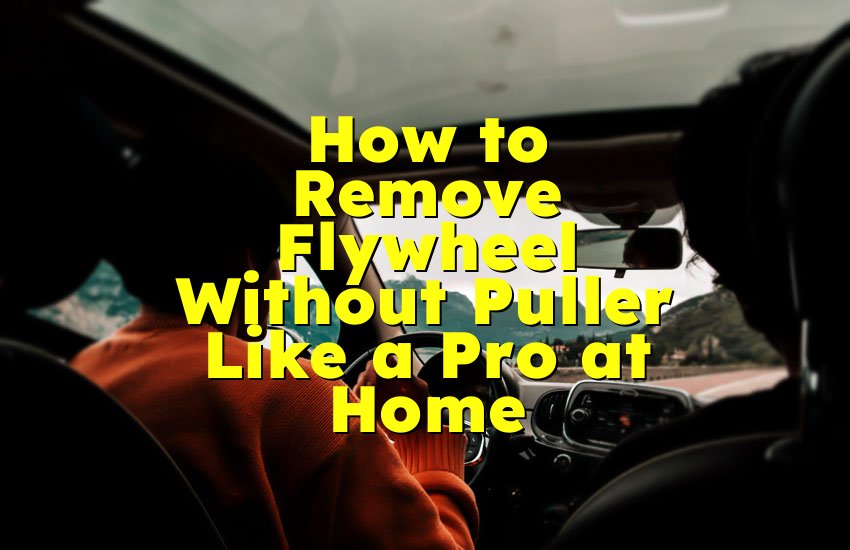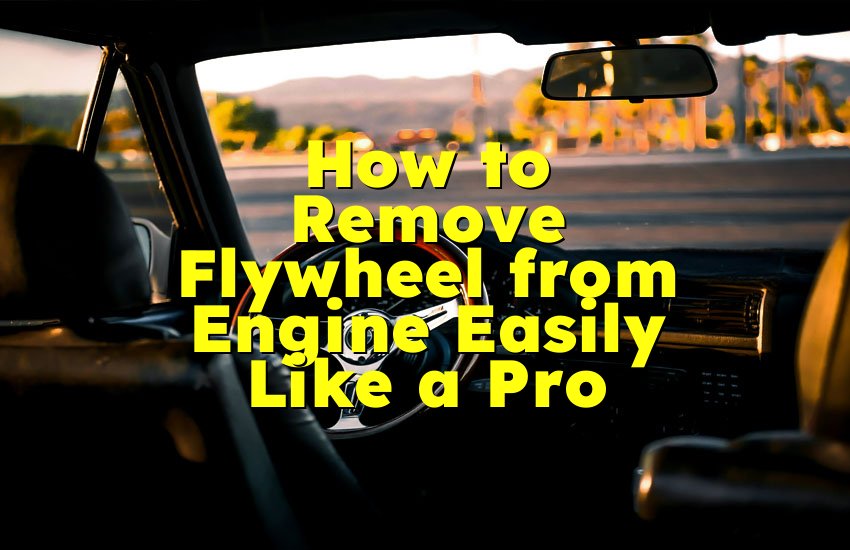As an Amazon Associate, I earn from qualifying purchases at no extra cost to you.
How to Tell If a Flywheel Is Bad — Signs You Shouldn’t Ignore
It usually starts with a strange vibration when you press the clutch, or maybe a rattling noise that just won't stop. You might think it's just a loose part or a bad mount, but sometimes the real culprit is the flywheel. Many drivers overlook it until the problem gets worse. Let's walk through the clear signs and simple checks that can tell you if your flywheel is going bad.
Start by noticing if the clutch slips or makes grinding sounds during gear shifts, then check for vibration when idling. Listen for rattling or burning smells under the hood, especially when releasing the clutch. Observe if the engine hesitates or stalls when starting, and feel for jerky motion during acceleration. Finally, inspect for visible cracks or discoloration on the flywheel once removed.
Unusual Noises When Pressing the Clutch
When a flywheel starts to go bad, one of the first things you might hear is a strange grinding or rattling sound whenever you press the clutch pedal. This happens because the surface of the flywheel is no longer smooth, causing uneven friction with the clutch disc. Imagine metal dragging against metal—it's not only annoying but also a sign something deeper is wrong.
Sometimes, these noises come and go, which makes them easy to ignore. But that inconsistency often points to loose flywheel bolts or worn springs inside a dual-mass flywheel. A friend of mine once thought it was his transmission making the noise, but replacing the flywheel solved it instantly. That's why paying attention to early noises can save you a big repair bill later.
Another way to identify this sound is to listen carefully when shifting between gears. If the rattling fades once the clutch is fully engaged, it's often a flywheel problem rather than a gearbox issue. Over time, these noises will grow louder, especially in cold weather, when metal contracts and gaps widen.
If you ever hear clunking or knocking during takeoff, don't keep driving and hoping it'll go away. Flywheel failure can damage your clutch and transmission, turning a small issue into an expensive fix. A mechanic can quickly confirm it with a sound test or by inspecting through the inspection cover.
- Listen for rattling, clunking, or grinding while pressing the clutch.
- Noise fading when clutch is engaged usually means flywheel issues.
- Don't ignore inconsistent or temperature-sensitive noises.
Shaking or Vibration During Acceleration
A bad flywheel often causes noticeable vibration, especially when accelerating or idling. You might feel it through the clutch pedal, steering wheel, or even your seat. This shaking happens because the flywheel surface becomes warped or uneven, causing the clutch to grip and release unevenly. It's similar to driving with a warped brake rotor—you can feel the pulsing motion every time it engages.
Many drivers confuse this with engine misfires or bad motor mounts, but there's an easy way to tell. If the vibration only appears when pressing or releasing the clutch, your flywheel is the likely suspect. I once drove a car that shook so much during takeoff that I thought the driveshaft was broken—it turned out to be a deeply scored flywheel.
Vibration also increases when a dual-mass flywheel fails internally. The springs that absorb engine vibration weaken or break, causing the shaking to transfer directly into the cabin. It's more noticeable in manual cars, especially in lower gears. So if you feel that deep rumble during acceleration, it's worth checking the flywheel.
Ignoring this vibration can cause clutch chatter, uneven wear, and eventually complete clutch failure. Replacing a damaged flywheel early is cheaper than dealing with collateral damage later on.
- Feel for shaking or pulsing in clutch pedal or steering wheel.
- Stronger vibration during gear changes suggests flywheel issues.
- Address early to prevent clutch and gearbox damage.
Burning Smell or Slipping Clutch
A strong burning smell after driving in traffic or uphill can be another red flag. It often means the clutch is slipping against a damaged or glazed flywheel surface. That friction generates heat, and heat means trouble. The smell is hard to miss—it's sharp, metallic, and sometimes smoky inside the cabin.
In mild cases, the flywheel might just be dirty or slightly glazed, but if it's blue or discolored when removed, it's been overheated too many times. This usually happens from riding the clutch or heavy towing. Once overheated, the flywheel hardens and develops hot spots, which reduce friction and make slipping worse over time.
If you feel your engine revving higher but your car isn't speeding up as it should, that's clutch slip caused by a bad flywheel. It's especially noticeable in higher gears or when accelerating quickly. Keep an eye on your RPM gauge—it's one of the easiest clues to spot.
A good trick is to drive on a flat road in third gear and slowly release the clutch without accelerating. If the car doesn't stall quickly or the RPM rises instead, your clutch or flywheel is slipping.
- Burning smell often means overheating flywheel surface.
- Clutch slipping shows loss of friction from damaged flywheel.
- Check for blue discoloration or hot spots when inspected.
Difficulty Starting the Engine
When the flywheel is damaged, starting your car may suddenly become harder. The flywheel teeth engage with the starter motor's gear to crank the engine. If those teeth are worn, chipped, or missing, you'll hear a clicking or grinding sound instead of the smooth cranking noise you expect.
I once worked on an old sedan that had this exact issue. Every few starts, it would grind loudly before catching. When we checked, several flywheel teeth were missing. The starter was spinning but couldn't grip properly. That's why this symptom shouldn't be ignored—it's an early warning that the flywheel's outer ring gear needs replacement.
Sometimes the car starts normally for days, then suddenly refuses to crank. That's because the flywheel always stops in a slightly different position, so the starter may occasionally hit a damaged section. It's frustrating, but at least it's a very telling sign.
If you suspect this issue, remove the starter motor and inspect the flywheel teeth with a flashlight. Damaged teeth will look jagged or shiny on the edges. Replacing the flywheel or ring gear fixes the problem and prevents future starter wear.
- Grinding or clicking when starting means worn flywheel teeth.
- Intermittent starting issues often linked to missing gear teeth.
- Replace flywheel ring gear before it damages the starter.
Jerky Gear Changes or Poor Shifting
A healthy flywheel helps your clutch engage smoothly. When it's bad, gear changes start feeling rough, jerky, or hesitant. The clutch may not release fully, making it hard to slot gears without grinding. It feels like something's dragging, and sometimes you even hear a clunk when changing gears.
This issue often shows up during quick shifts or stop-and-go driving. If you notice gear grinding despite a properly adjusted clutch pedal, that's a sign the flywheel's surface isn't flat anymore. The clutch disc struggles to separate cleanly, causing drag.
In cars with dual-mass flywheels, worn internal springs can also make shifts inconsistent. Sometimes it feels smooth, other times jerky. That inconsistency is what usually confuses drivers. A friend of mine ignored it for months until the clutch finally burned out, leaving him stranded during rush hour.
It's worth noting that if you also hear a clunk or feel the clutch pedal vibrating when engaging gears, it's time to inspect the flywheel closely. Driving longer with poor shifting can quickly wear down the transmission synchros too.
- Hard shifting or grinding gears show uneven flywheel surface.
- Jerky motion points to worn dual-mass flywheel springs.
- Early repair prevents clutch and transmission wear.
Visible Damage or Discoloration
Sometimes, the easiest way to tell if a flywheel is bad is simply by looking at it. Once removed, a good flywheel has a clean, smooth, silver-gray surface. A bad one often shows blue spots, cracks, or uneven wear marks. Those are signs of overheating or excessive friction.
Cracks usually appear around the bolt holes or near the center hub. They may look small, but they can spread quickly under heat and stress. I once saw a cracked flywheel literally break apart during high revs—it's dangerous and can damage the transmission housing.
Discoloration, especially blue or purple hues, means it has been overheated. Overheating changes the metal hardness, leading to uneven clutch contact. If you see deep grooves or ridges, resurfacing might not be enough; replacement is safer.
While checking, also look for oil contamination. A leaking rear main seal can cause oil to soak the flywheel, leading to clutch slip and faster wear. Cleaning won't fix that—you'll need to replace the seal and flywheel together.
- Blue or purple spots show overheating damage.
- Cracks or grooves mean replacement is required.
- Oil-stained flywheel points to rear main seal leak.
Final Thoughts
Spotting a bad flywheel early can save you from expensive repairs and sudden breakdowns. From odd noises to shaking or starting trouble, each sign gives you a small clue. Paying attention to these symptoms and getting a quick inspection done is always worth it. A healthy flywheel keeps your engine, clutch, and gearbox working smoothly together for years.
| Symptom | Possible Cause | What to Do |
|---|---|---|
| Grinding noise when pressing clutch | Worn or damaged flywheel surface | Inspect and replace flywheel |
| Vibration during acceleration | Warped flywheel or failed springs | Check balance and replace if uneven |
| Burning smell | Overheated or glazed flywheel | Replace and avoid riding clutch |
| Hard starting | Damaged flywheel ring gear | Inspect teeth, replace if chipped |
| Jerky shifting | Uneven clutch engagement | Replace or resurface flywheel |
| Clutch slipping | Glazed or oily surface | Clean, replace seal, or install new flywheel |
| Blue discoloration | Overheating damage | Replace with new flywheel |
| Knocking on takeoff | Loose bolts or spring failure | Tighten bolts or replace assembly |
Frequently Asked Questions (FAQs)
Is it safe to drive with a bad flywheel?
Driving with a bad flywheel is risky because it can suddenly fail, causing loss of clutch control or transmission damage. You might notice stronger vibrations or slipping before it breaks completely. Even if it seems manageable, the stress on the clutch and starter increases with every drive. Getting it inspected early is safer and much cheaper than waiting for a complete failure.
Can a flywheel be repaired instead of replaced?
Some flywheels can be resurfaced if the damage is minor and the thickness allows it. However, if it's cracked, discolored, or has damaged springs (in dual-mass types), replacement is the only reliable option. Repairing heavily worn ones rarely lasts long. It's better to replace it once and avoid repeated labor costs later.
Do I need to replace the clutch when replacing the flywheel?
It's highly recommended to replace the clutch when you replace the flywheel. Both parts wear together, and installing a new flywheel with an old clutch can cause uneven wear or slippage. Since labor costs are similar for both, replacing them together saves time and money in the long run.
Is it normal for a flywheel to make noise?
A slight humming noise is okay, but any rattling, clunking, or grinding isn't normal. These sounds suggest loosened bolts, worn springs, or an unbalanced flywheel. Noise is usually the first sign of trouble, so catching it early helps prevent further damage. A mechanic can pinpoint the cause quickly with a stethoscope check.
Can a bad flywheel cause starting problems?
Yes, because the flywheel engages directly with the starter motor. If its teeth are worn or missing, the starter gear can't catch properly. You'll hear a clicking or grinding sound when trying to start the engine. It may still start occasionally, but that's only when the worn section isn't aligned. Replacing the ring gear solves this issue.
Do I need special tools to inspect the flywheel?
Basic tools like a socket set, flashlight, and flywheel locking tool are enough for inspection. You'll need to remove the transmission, which requires some mechanical skill. If you're not comfortable doing that, a mechanic can check it quickly using a borescope through the inspection cover. It's worth doing before assuming clutch problems.
Is resurfacing a dual-mass flywheel a good idea?
No, dual-mass flywheels shouldn't be resurfaced because they contain internal dampers and springs that can't be reset. Resurfacing removes material unevenly and ruins their balance. Always replace them as complete units. Single-mass flywheels, however, can be resurfaced safely if within factory limits.
Can a bad flywheel affect fuel efficiency?
Yes, a damaged flywheel can reduce fuel efficiency. When it slips or vibrates, the engine works harder to transfer power to the wheels. This wasted energy means more fuel is burned. Over time, you might notice a slight drop in mileage, especially in city driving. Replacing a bad flywheel can restore smooth power transfer and better efficiency.











